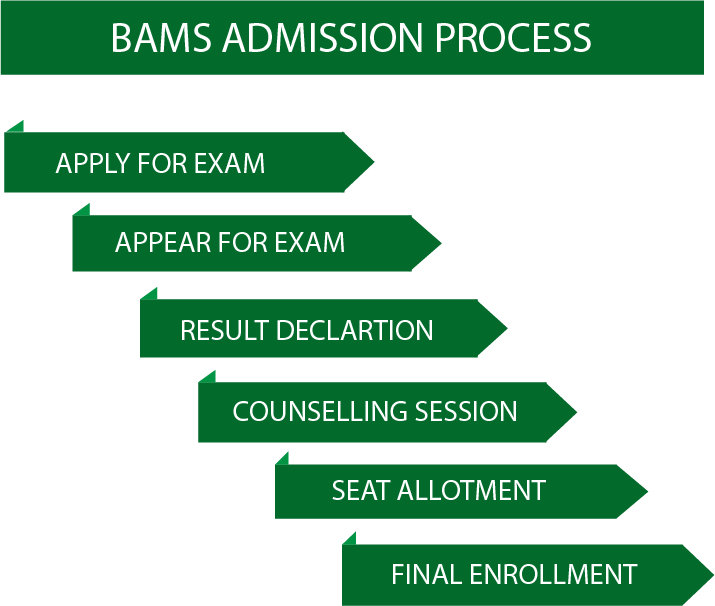
FEE STRUCTURE
B.A.M.S COURSE (SESSION 2025–26)
| Year | Tuition Fees | Registration Fees | Security Fees | Total Fees |
|---|---|---|---|---|
| First Year | ₹ 2,20,000 | ₹ 10,000 | ₹ 50,000 | ₹ 2,80,000 |
| Second Year | ₹ 2,20,000 | – | ₹ 2,20,000 | |
| Third Year | ₹ 2,20,000 | – | ₹ 2,20,000 | |
| Fourth Year | ₹ 2,20,000 | – | ₹ 2,20,000 | |
| Fifth Year | ₹ 1,10,000 | – | ₹ 1,10,000 | |
| TOTAL FEES | ₹ 10,50,000 | |||
HOSTEL FEES ANNUALLY: ₹ 1,20,000
COLLEGE BANK ACCOUNT DETAILS
| Name: | DRONACHARYA AYURVEDIC EDUCATIONAL INSTITUTE & HOSPITAL |
| Account Number: | 50200076612222 |
| IFSC Code: | HDFC0003784 |
| UPI-ID: | 9557529922@hdfcbank |
| Branch Address: | HDFC BANK, Nehru Colony Dehradun (Uttarakhand) |
Bachelor of Ayurvedic Medicine and Surgery (B.A.M.S.)
B.A.M.S. is a 5.5 years long graduate degree that integrates the study of modern medicine and traditional Ayurveda. This includes 4.5 years of academic education followed by a 1-year mandatory internship in hospitals or Ayurvedic centers.
The B.A.M.S. curriculum covers a wide range of subjects such as Physiology, Modern Anatomy, Pharmacology, Medicine, ENT, Forensic Medicine, principles of surgery, and the fundamentals of Ayurvedic science like herbal medicine, diagnostics, and traditional therapies.
Students pursuing B.A.M.S. need a high level of focus, concentration, and dedication, as it involves studying both contemporary science and ancient Ayurvedic texts.
Ayurveda is gaining widespread popularity, not only in India but globally, especially in the Western world due to its natural healing techniques with minimal side effects. Most Ayurvedic treatments involve medicines prepared from natural herbs, plants, and vegetables.
This course is ideal for students genuinely interested in the Ayurvedic system of medicine and those looking to build a career in the healthcare sector through the application of age-old traditional healing.
► Introduction & Year-wise Subject Details of B.A.M.S.
Duration: 5½ Years (3 x 18-Month Professional Years + 1-Year Internship)
Approved by: NCISM, Ministry of AYUSH, Govt. of India
| Year | Duration | Subjects | Highlights |
|---|---|---|---|
| First Professional Year | 18 Months |
|
Foundation in philosophy, language, anatomy, and physiology |
| Second Professional Year | 18 Months |
|
Ayurvedic pharmacology, pharmacy, pathology, diagnostics |
| Final Professional Year | 18 Months |
|
Clinical specialization, surgery, emergency, research focus |
| Internship | 12 Months | Rotatory internship in all departments (Kayachikitsa, Panchakarma, Surgery, ENT, Gynecology, Pediatrics, etc.) | Hands-on clinical experience in hospital & OPD |
Minimum Eligibility Criteria for B.A.M.S.
| Academic Qualification | 10+2 with Physics, Chemistry, Biology/Biotechnology as main subjects |
| Minimum Marks Required | General Category: 50% in PCB SC/ST/OBC: 40% in PCB |
| Age Requirement | 17 years as on or before 31st December of the admission year |
| Maximum Age Limit | No upper limit (subject to NCISM/NEET-UG regulations) |
| Qualifying Exam | Must qualify NEET-UG |
Career Opportunities After B.A.M.S.
- Ayurvedic Medical Officer
- Clinical Practitioner
- MD/MS Ayurveda
- Panchakarma Expert
- Academic/Teaching Career
- Research and Development in Herbal Medicine
- Hospital & Healthcare Management
- Pharmaceutical Industry
- Wellness and Yoga Therapy Centers

Eligibility Criteria?

After scores are obtained in the NEET, centralized counselling takes place which decides your place in a college based on your performance. Colleges may take personal interview round afterward to further screen the students.
BAMS Scope
With an upsurge of countless grave health issues and limitations of allopathy, Ayurveda has emerged as an alternative. Therefore, BAMS as a medical course is gaining popularity not just in India but all over the world. With almost zero side effects, ayurveda is being increasingly opted by people all over the globe. People suffering from lifestyle diseases also seek help in the traditional art of healing which indicates the growing demand of BAMS doctors.
There are plenty of job opportunities for BAMS graduates which includes joining a government or private hospital as an ayurvedic specialist or start up a private clinic.
Another sector that is up and coming for BAMS graduates is Research which branch out to a diverse range of areas where a research can be conducted. Teaching Ayurveda is another area where a BAMS graduate can secure a decent livelihood.
After the completion of the BAMS course, candidates can either opt for practicing or may pursue higher studies and specialise in a particular branch of ayurveda. A BAMS graduate is required to take up one year of internship to have practical experience which is equally required for becoming a successful practitioner. Along with regular practice, a BAMS graduate can also take up specialized practice after pursuing higher education in the discipline, e.g., therapy of skin diseases, spinal disorders, ophthalmologic conditions, ano-rectal diseases, etc.